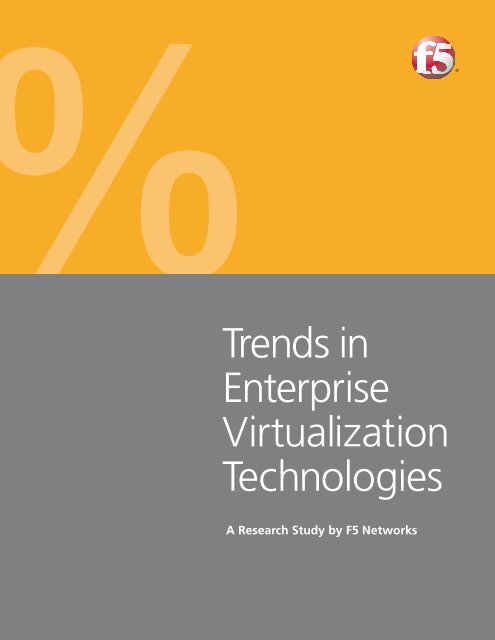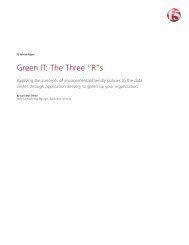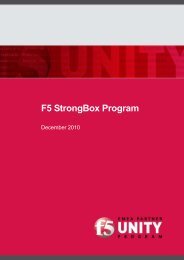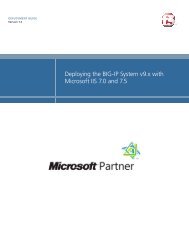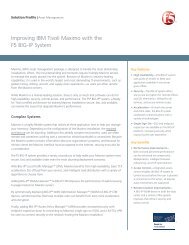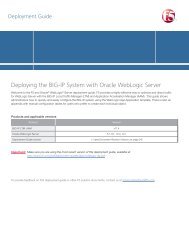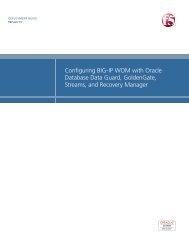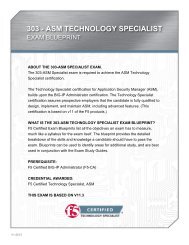Trends in Enterprise Virtualization Technologies | F5 Networks
Trends in Enterprise Virtualization Technologies | F5 Networks
Trends in Enterprise Virtualization Technologies | F5 Networks
You also want an ePaper? Increase the reach of your titles
YUMPU automatically turns print PDFs into web optimized ePapers that Google loves.
<strong>Trends</strong> <strong>in</strong><br />
<strong>Enterprise</strong><br />
<strong>Virtualization</strong><br />
<strong>Technologies</strong><br />
A Research Study by <strong>F5</strong> <strong>Networks</strong>
What’s Inside<br />
Survey Overview and Objectives 2<br />
Methodology 2<br />
Key F<strong>in</strong>d<strong>in</strong>gs 3<br />
Detailed F<strong>in</strong>d<strong>in</strong>gs 4<br />
Comb<strong>in</strong><strong>in</strong>g Key Learn<strong>in</strong>gs to 13<br />
Identify <strong>Trends</strong><br />
2<br />
<strong>Trends</strong> <strong>in</strong> <strong>Enterprise</strong> <strong>Virtualization</strong> <strong>Technologies</strong><br />
Survey Overview and Objectives<br />
Is virtualization “the next big th<strong>in</strong>g,” or is it already here? This research was conducted by<br />
<strong>F5</strong> <strong>Networks</strong> ® to learn:<br />
• The extent to which enterprises have adopted virtualization technologies<br />
• What drivers cause enterprises to use virtualization<br />
• In enterprises that are us<strong>in</strong>g virtualization, what are they us<strong>in</strong>g it for<br />
• What virtualization products are most popular<br />
• What applications are most commonly virtualized<br />
• What barriers cause enterprises to postpone or decide aga<strong>in</strong>st virtualization<br />
Methodology<br />
The sample for this survey was selected across an audience of IT professionals <strong>in</strong>terested <strong>in</strong><br />
virtualization. Most of the respondents work <strong>in</strong> North America, while some work <strong>in</strong> EMEA.<br />
We conducted the survey via email between September and December of 2008. The email<br />
address lists came from:<br />
• VMworld, a large conference about virtualization 1<br />
• An event held by VMware for their user group <strong>in</strong> Boston 2<br />
• Microsoft TechEd 2008, both <strong>in</strong> the US and EMEA 3<br />
• A product launch event for Microsoft <strong>Virtualization</strong> 4<br />
• People who downloaded virtualization white papers from the <strong>F5</strong> website 5<br />
The survey was sent to 3,285 recipients <strong>in</strong> all, and was completed by 312. Overall we consider<br />
this a fairly representative random sample, with two possible exceptions: first, based on the<br />
lists used, respondents us<strong>in</strong>g Microsoft products could be over-represented compared to<br />
the general market. Second (also based on the lists used), IT adm<strong>in</strong>istrators who prefer open<br />
source solutions might not be adequately represented <strong>in</strong> the results.<br />
1 www.vmworld.com/community/conferences/2008/<br />
2 http://communities.vmware.com/community/vmug/us_northeast/boston<br />
3 https://2008.msteched.com/itpro/public/precons.aspx<br />
4 www.microsoft.com/virtualization/default.mspx<br />
5 www.f5.com/solutions/resources/white-papers/
Key F<strong>in</strong>d<strong>in</strong>gs:<br />
<strong>Virtualization</strong> today is mission critical. A strong majority of respondents (64%) are<br />
virtualiz<strong>in</strong>g mission-critical applications.<br />
The bus<strong>in</strong>ess reason for most virtualization projects: server consolidation.<br />
Eighty-two percent of network adm<strong>in</strong>istrators listed “server consolidation” as the reason<br />
for their virtualization <strong>in</strong>itiatives. Almost two-thirds (63%) use virtualization to reduce power<br />
and space requirements.<br />
Server virtualization dom<strong>in</strong>ates. <strong>Virtualization</strong> of storage, network, and desktops will<br />
grow <strong>in</strong> 2009, but will still trail server virtualization significantly.<br />
VMware ESX is by far the most widely deployed technology. Three-quarters (75%)<br />
of the survey respondents use VMware ESX.<br />
Microsoft and Oracle dom<strong>in</strong>ate the list of apps that organizations virtualize.<br />
Respondents are virtualiz<strong>in</strong>g popular bus<strong>in</strong>ess applications (Exchange, SQL, IIS, SharePo<strong>in</strong>t),<br />
but almost equal numbers virtualize custom <strong>in</strong>ternal applications and open source apps.<br />
Network adm<strong>in</strong>istrators worry about the affect of their network on virtualization,<br />
and the affect of virtualization on their network. Three-fourths of respondents (75%)<br />
feel network<strong>in</strong>g issues are at least somewhat of a barrier to virtualization. A nearly equal<br />
amount of network adm<strong>in</strong>istrators (74%) say that application performance is at least<br />
somewhat of a barrier to virtualization.<br />
<strong>Virtualization</strong> still has untapped potential for <strong>in</strong>tegration throughout the<br />
corporation. For 60% of virtualization projects, the organization’s server team drives<br />
implementation. Other aspects of the corporate network which could benefit greatly<br />
from virtualization, such as storage, network<strong>in</strong>g, applications, and desktops, added up<br />
to a slim m<strong>in</strong>ority of implemented projects.<br />
3
4<br />
Detailed F<strong>in</strong>d<strong>in</strong>gs<br />
<strong>Virtualization</strong> today is mission critical<br />
The survey asked, “Where do you have server virtualization currently deployed?” Respondents<br />
could choose multiple answers. Some respondents had no plans for server virtualization<br />
(6%), and some had it <strong>in</strong> test environments only (19%). But nearly two-thirds have deployed<br />
server virtualization <strong>in</strong> production, <strong>in</strong>clud<strong>in</strong>g mission-critical applications (64%).<br />
The most common response was that adm<strong>in</strong>istrators had deployed server virtualization <strong>in</strong><br />
a comb<strong>in</strong>ation of sett<strong>in</strong>gs: test, non-critical production, and critical production (40%).<br />
Test, production (non-critical and mission-critical applications)<br />
126<br />
Test only<br />
61<br />
Test, production (mission-critical applications)<br />
47<br />
Production (non-critical applications)<br />
22<br />
No plans for server virtualization<br />
19<br />
Production (non-critical and mission-critical applications)<br />
15<br />
Production (mission-critical applications)<br />
14<br />
0 30 60 90 120 150<br />
Number of responses
The bus<strong>in</strong>ess reason for most virtualization projects: server consolidation<br />
The survey asked, “What are the primary bus<strong>in</strong>ess results you hope to achieve deploy<strong>in</strong>g<br />
server virtualization technology?” By far, the most common response was server<br />
consolidation (82%). The other bus<strong>in</strong>ess drivers given were, <strong>in</strong> descend<strong>in</strong>g order 6 :<br />
What are the primary bus<strong>in</strong>ess results<br />
you hope to achieve deploy<strong>in</strong>g server<br />
virtualization technology?<br />
Server consolidation 82%<br />
Reduce power and space requirements 63%<br />
Faster application and service provision<strong>in</strong>g 59%<br />
Improved manageability 53%<br />
Bus<strong>in</strong>ess cont<strong>in</strong>uity 51%<br />
Other (most responses specified “test<strong>in</strong>g”) 6%<br />
Server consolidation<br />
Reduce power and space requirements<br />
Faster application and service provision<strong>in</strong>g<br />
Improved manageability<br />
Bus<strong>in</strong>ess cont<strong>in</strong>uity<br />
Other (most responses specified “test<strong>in</strong>g”)<br />
0% 20% 40% 60% 80% 100%<br />
The strong show<strong>in</strong>g for “reduce power and space requirements” (63%) <strong>in</strong>dicates that the<br />
need to reduce operat<strong>in</strong>g expenses might have comb<strong>in</strong>ed with pro-environmental “green”<br />
considerations to ga<strong>in</strong> traction <strong>in</strong> the marketplace as reasons for virtualiz<strong>in</strong>g. The fact that six<br />
different reasons for virtualiz<strong>in</strong>g each drew a positive response from more than half the IT<br />
professionals (51 – 82%) <strong>in</strong>dicates that virtualization is not a technology solution <strong>in</strong> search of<br />
a problem—respondents perceive numerous reasons for virtualiz<strong>in</strong>g as legitimate.<br />
6 Totals add up to more than 100% because respondents could give multiple answers.<br />
%<br />
5
6<br />
Server virtualization dom<strong>in</strong>ates<br />
In theory, all k<strong>in</strong>ds of comput<strong>in</strong>g technologies can be virtualized. However, when asked<br />
“What type of virtualization do you currently have deployed?”, 82% of respondents<br />
answered, “server virtualization.” All other answers lagged far beh<strong>in</strong>d:<br />
What type of virtualization do you<br />
currently have deployed?<br />
Server virtualization 82%<br />
Storage virtualization 33%<br />
Network virtualization 22%<br />
None 14%<br />
Service virtualization (cloud comput<strong>in</strong>g) 7%<br />
Server virtualization<br />
Storage virtualization<br />
Network virtualization<br />
None<br />
Service virtualization (cloud comput<strong>in</strong>g)<br />
0% 20% 40% 60% 80% 100%<br />
Of the 82% who answered “server virtualization,” half had deployed only server virtualization<br />
and no other type of virtualization.<br />
However, other types of virtualization seem poised for growth <strong>in</strong> 2009. The survey asked,<br />
“Which type of virtualization will you deploy <strong>in</strong> 2009?” Responses broke out as follows:<br />
%
Which type of virtualization will you<br />
deploy <strong>in</strong> 2009?<br />
Server virtualization 71%<br />
Storage virtualization 44%<br />
Network virtualization 30%<br />
Service virtualization (cloud comput<strong>in</strong>g) 17%<br />
None 10%<br />
Other (mostly desktop) 7%<br />
Server virtualization<br />
Storage virtualization<br />
Network virtualization<br />
Service virtualization (cloud comput<strong>in</strong>g)<br />
None<br />
Other (mostly desktop)<br />
0% 10% 20% 30% 40% 50% 60% 70% 80%<br />
The numbers <strong>in</strong>dicate that although server virtualization will cont<strong>in</strong>ue to lead the migration<br />
to virtualization technologies, all other types of virtualization will pick up by 11% relative<br />
to server virtualization. If servers alone sacrifice some share of the virtualization niche, that<br />
share might be taken largely by storage virtualization, which drew 33% of responses for<br />
2008 but 44% for 2009. That growth would make storage the second-hottest category<br />
among virtualization technologies.<br />
The response “none,” <strong>in</strong>dicat<strong>in</strong>g no plans to virtualize, drew 14% for 2008. The “none”<br />
response fell to 10% for 2009—a possible <strong>in</strong>dicator of mild growth for the virtualization<br />
market to help mitigate operat<strong>in</strong>g expenses <strong>in</strong> a weakened world economy.<br />
%<br />
7
8<br />
VMware ESX is by far the most widely deployed technology<br />
When asked which specific virtualization products they currently use, three-quarters<br />
of the survey respondents (75%) cited VMware ESX. Respondents could choose multiple<br />
answers, but most of the runners-up were other VMware products; <strong>in</strong> total, VMware<br />
products absorbed 88% of all responses:<br />
Which virtualization products do you use? %<br />
VMware ESX 75%<br />
VMware VirtualCenter 59%<br />
VMware DRS/HA/VMotion/<br />
Storage VMotion<br />
47%<br />
VMware VDI 17%<br />
Other 15%<br />
Microsoft Hyper-V 12%<br />
XenSource 8%<br />
VMware ESX<br />
VMware VirtualCenter<br />
VMware DRS/HA/VMotion/Storage VMotion<br />
VMware VDI<br />
Other<br />
Microsoft Hyper-V<br />
XenSource<br />
0% 10% 20% 30% 40% 50% 60% 70% 80%<br />
Microsoft’s relatively weak show<strong>in</strong>g is hardly a surprise, s<strong>in</strong>ce Hyper-V came out of beta<br />
mid-year (June 2008). Though only 12% of respondents had deployed Hyper-V <strong>in</strong> 2008,<br />
24% claimed they <strong>in</strong>tended to deploy it <strong>in</strong> 2009, which would be respectable growth for<br />
Microsoft’s virtualization product.<br />
In answer<strong>in</strong>g questions about their deployment plans for 2009, the respondents <strong>in</strong>dicated<br />
slower growth for VMware overall. We attribute this to the fact that a large swath of the<br />
potential market has already completed the <strong>in</strong>itial deployment of virtualization technology.<br />
However, VMware VDI seems poised to grow; <strong>in</strong>tended deployments for 2009 drew 23%<br />
of responses, compared to 17% <strong>in</strong> 2008.
Microsoft and Oracle dom<strong>in</strong>ate the list of apps that organizations virtualize<br />
Products from Microsoft and Oracle dom<strong>in</strong>ate network adm<strong>in</strong>istrators’ list of virtualized<br />
applications, with Microsoft SQL Server show<strong>in</strong>g as the “most virtualized” app (48%)<br />
and Microsoft Internet Information Services (IIS) follow<strong>in</strong>g closely (45%). But just as much,<br />
organizations also virtualize their own custom applications. Here are the responses to<br />
the question, “Which of the follow<strong>in</strong>g applications do you have runn<strong>in</strong>g <strong>in</strong> virtualized<br />
production environments?”<br />
Which applications do you have runn<strong>in</strong>g<br />
<strong>in</strong> virtual production environments?<br />
Microsoft SQL Server 48%<br />
Homegrown applications 48%<br />
Microsoft IIS 45%<br />
Open source applications 34%<br />
Microsoft SharePo<strong>in</strong>t Server 32%<br />
Microsoft Exchange Server 29%<br />
Other 20%<br />
Oracle 10g 15%<br />
Microsoft Office Communications Server 11%<br />
Oracle PeopleSoft 5%<br />
SAP ERP 5%<br />
Oracle E-Bus<strong>in</strong>ess Suite 4%<br />
Oracle Siebel 3%<br />
%<br />
The amount of organizations virtualiz<strong>in</strong>g open source applications (34%) seems strong,<br />
given that the open source community was not a particular target of the survey. The<br />
comb<strong>in</strong>ed responses for homegrown applications (48%) and open source applications (34%)<br />
show that organizations are not afraid to roll up their sleeves and customize if they deem<br />
the effort worthwhile.<br />
9
10<br />
Network adm<strong>in</strong>istrators worry about the affect of their network on virtualization,<br />
and the affect of virtualization on their network<br />
For organizations that have not yet deployed virtualization technology, their concerns run<br />
<strong>in</strong> two directions: they worry that their network might restrict the operation and benefits<br />
of virtualization; and they worry that virtualization might hamper their network.<br />
When asked “What are the barriers for adopt<strong>in</strong>g server virtualization <strong>in</strong> a production<br />
environment?”, three-fourths of respondents (75%) feel network<strong>in</strong>g issues are at least<br />
somewhat to blame. However, an almost equal amount (74%) worried that virtualization,<br />
with its <strong>in</strong>tensive process<strong>in</strong>g demands, might impede application performance.<br />
What are the barriers for adopt<strong>in</strong>g<br />
server virtualization?<br />
Not a<br />
barrier<br />
Somewhat<br />
of a barrier<br />
Scalability 48 36 16<br />
App performance 26 40 34<br />
Management/availability 41 38 21<br />
Network issues 25 41 34<br />
Budget 40 46 14<br />
100%<br />
80%<br />
60%<br />
40%<br />
20%<br />
0%<br />
Scalability<br />
App performance<br />
Management/<br />
availability<br />
Network issues<br />
Budget<br />
Is a barrier<br />
Somewhat of a barrier<br />
Not a barrier<br />
Is a barrier
For another view of the same data, the follow<strong>in</strong>g table comb<strong>in</strong>es the responses to<br />
“Somewhat of a barrier” and “Is a barrier” <strong>in</strong>to one column, “Probably a barrier.”<br />
This view discards represent<strong>in</strong>g the <strong>in</strong>tensity of concern felt, <strong>in</strong> exchange for reflect<strong>in</strong>g<br />
what areas of concern were most widely expressed:<br />
What are the barriers for adopt<strong>in</strong>g<br />
server virtualization?<br />
Probably a<br />
barrier<br />
Network issues 75 25<br />
App performance 74 26<br />
Budget 60 40<br />
Management/availability 59 41<br />
Scalability 52 48<br />
100%<br />
80%<br />
60%<br />
40%<br />
20%<br />
0%<br />
Network issues<br />
App<br />
performance<br />
Budget<br />
Management/<br />
availability<br />
Scalability<br />
Not a<br />
barrier<br />
Probably a barrier<br />
Not a barrier<br />
We’re surprised to see scalability listed as a barrier by more than half the respondents, s<strong>in</strong>ce<br />
scalability is actually one of the major strengths of virtualization. Indeed, all the concerns perceived<br />
as barriers to adoption have exist<strong>in</strong>g, proven solutions; however, as expressed <strong>in</strong> these<br />
responses, the general IT community is either unaware of such solutions, or rema<strong>in</strong>s skeptical<br />
of vendor claims.<br />
11
12<br />
<strong>Virtualization</strong> still has untapped potential for <strong>in</strong>tegration throughout<br />
the corporation<br />
Who <strong>in</strong> the company is driv<strong>in</strong>g the move to server virtualization, or other virtualization<br />
projects? When asked this question, 60% of the respondents said that their organization’s<br />
server team drove the projects. Outside of projects by the server team, the percentage of<br />
other virtualization projects dropped sharply:<br />
Application team<br />
Other<br />
Network team<br />
10%<br />
19%<br />
9%<br />
QA team<br />
2%<br />
Seerver<br />
team<br />
These figures suggest that very few organizations have begun explor<strong>in</strong>g the potential of<br />
<strong>in</strong>tegrat<strong>in</strong>g virtualization across departments. Synergistic benefits might arise from, for<br />
example, virtualiz<strong>in</strong>g applications and a SANS system on virtualized servers, so that resources<br />
can spawn themselves upon demand and collapse themselves when no longer needed.<br />
Such multi-faceted projects rema<strong>in</strong> relatively unexplored, leav<strong>in</strong>g the virtualization market<br />
considerable headroom for further maturation.<br />
60%
Comb<strong>in</strong><strong>in</strong>g Key Learn<strong>in</strong>gs to Identify <strong>Trends</strong><br />
<strong>Virtualization</strong> at the start of 2009 can no longer be called “bleed<strong>in</strong>g edge” or early adopter<br />
technology—it is ma<strong>in</strong>stream. As shown <strong>in</strong> this report, two-thirds of all organizations are<br />
implement<strong>in</strong>g virtualization <strong>in</strong> live production, for mission-critical applications. <strong>Virtualization</strong><br />
is here and is no longer perceived as risky or unreliable technology (note that <strong>in</strong> the<br />
list of barriers to deployment, “reliability” or “availability” did not show up at all). In fact,<br />
IT professionals can cite numerous legitimate reasons why virtualization is a good idea.<br />
There is plenty of room for growth <strong>in</strong> how—and how much—virtualization solutions<br />
permeate an organization’s IT environment. Storage virtualization looks to be the next big<br />
area of growth and deployment.<br />
Thus, <strong>in</strong> 2009, virtualization deployment enters the phase of matur<strong>in</strong>g. The market’s desire<br />
for virtualization is real, and because virtualization reduces long-term operat<strong>in</strong>g expenses,<br />
deployments seem poised for growth even <strong>in</strong> a contract<strong>in</strong>g world economy. We expect<br />
that by this time next year, more than two-thirds of organizations will be rely<strong>in</strong>g daily on<br />
virtualized mission-critical applications. And many more than <strong>in</strong> 2008 will have multi-faceted,<br />
cross-departmental virtualization that harmonizes server, storage, and network resources.<br />
13
<strong>F5</strong> <strong>Networks</strong>, Inc. 401 Elliott Avenue West, Seattle, WA 98119 888‑882‑4447 www.f5.com<br />
<strong>F5</strong> <strong>Networks</strong>, Inc.<br />
Corporate Headquarters<br />
<strong>in</strong>fo@f5.com<br />
<strong>F5</strong> <strong>Networks</strong><br />
Asia‑Pacific<br />
<strong>in</strong>fo.asia@f5.com<br />
<strong>F5</strong> <strong>Networks</strong> Ltd.<br />
Europe/Middle‑East/Africa<br />
emea<strong>in</strong>fo@f5.com<br />
<strong>F5</strong> <strong>Networks</strong><br />
Japan K.K.<br />
f5j‑<strong>in</strong>fo@f5.com<br />
© 2009 <strong>F5</strong> <strong>Networks</strong>, Inc. All rights reserved. <strong>F5</strong>, <strong>F5</strong> <strong>Networks</strong>, the <strong>F5</strong> logo, BIG‑IP, FirePass, iControl, TMOS, and VIPRION are trademarks<br />
or registered trademarks of <strong>F5</strong> <strong>Networks</strong>, Inc. <strong>in</strong> the U.S. and <strong>in</strong> certa<strong>in</strong> other countries. CS56856 0509


